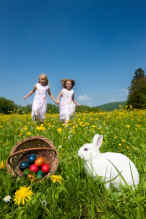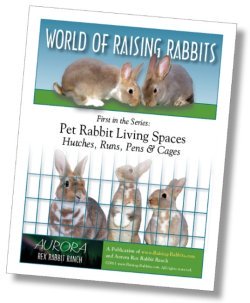

Rabbit Rhythms of AprilGreen Feed Every imaginable hue of green assaults our senses in April - green buds on every bush...the lawn finally remembers it has roots...the trees leaf out as though springtime deserves a rowdy welcome. Out come the lawnmower, the weed-whacker and the hedge-trimmer. The fruit of just one Saturday’s yard-work can leave you with a huge mound of fresh green debris. Debris?? Or free rabbit food? Well sure! Why not feed that (pesticide-free) grass and those yard clippings to your rabbits? Fresh green recently shorn yard clippings are a nutritious, and free, addition to your rabbits’ dinner-plate.
Both pet rabbits and livestock rabbits can profit from eating green. They’re herbivores - it’s the main natural diet for them, unlike that of omnivore humans. So save your coins and feed green.
Pet Rabbit Living SpacesSpeaking of saving a bundle...
We think that every single project that you build yourself will save you a minimum of US$10 to $20 right now, and much more over the long term in both longevity of your rabbit and your hutches and cages. Which means that at the extremely low introductory price of $4.99, you can’t afford NOT to purchase Pet Rabbit Living Spaces!
on our Rabbit Cage Plans Page
In the News RecentlyFrom the Times of India:"Pets bust stress and make you humane" The emotional benefits of caring for pets are huge, according to the Times of India. "Unconditional love from a pet is a therapy on its own. All one needs to do is indulge in it," concludes the article's author, Nimisha Tiwari. Well put! Once we can grasp the meaning of unconditional love through the nonjudgmental love of a pet, and then practice that love towards the (unlovable) humans in our lives, our own humanity grows. Who knows, even hurts and wounds can heal, for "love covers a multitude of sins" (1 Pet 4:9). Who doesn't need a little healing now and again? Dogs and rabbits are two ideal animals from which to observe and experience the reality of true, unconditional love.
Easter is Just Around the Corner! Easter is about a divine and unconditional love, a love beyond the ability of humans to fully grasp.
Easter is about a divine and unconditional love, a love beyond the ability of humans to fully grasp. Maybe that's why, instead of love, you'll hear tales of the Easter Bunny and Easter eggs. The stories are cute and colorful, of course, but you and I both know that rabbits don’t lay eggs! I know - disappointing... The Easter Bunny history is linked to pagan gods of fertility. Bunnies and eggs are logical symbols of fertility and new life, which the Germans, apparently, first connected together over 400 years ago. But I promise you - the REAL Easter history is far more miraculous than an egg-laying rabbit. What would a rabbit website be without a proper history of Easter??
Healthy RabbitsDysbiosisIn rabbits, dysbiosis is the condition of an imbalance of microorganisms in the hind-gut, or cecum.
Does your rabbit have diarrhea? Or, are you seeing the soft round grape-like ‘night-droppings’ officially known as cecotropes? These are completely normal. Rabbits eat their 'vitamins' straight from the hind end in the form of their very soft cecotropes. If one of these soft lumpy cecotropes happens to drop, and then the rabbit steps in it, you might think the rabbit has the runs, because a squished cecotrope is brown, sticky and messy. But no, there’s no mistaking diarrhea - it completely fouls the rabbit’s rear. The rabbit is bloated, lethargic, and the tummy may make sloshing noises if you pick it up. If your rabbit shows these symptoms, it is critically ill. Rabbits between the age of 5 weeks to 9 weeks are most prone to sudden death from enterotoxemia, triggered by the dysbiosis (gut flora imbalance). This is because their guts are still making the transition from sterility at 2 weeks old to correct levels of healthy gut flora by age 9+ weeks. But rabbits of any age may fall sick and even die, especially if given too much people-food or certain antibiotics. What to do:
Mild cases of dysbiosis may respond nicely to the high fiber in grass hay and some probiotics, such as Benebac. See See Rabbit Diarrhea.
Like this newsletter?Forward this email to your friends!Your friends at Raising-Rabbits.com wish you a Happy April, and a very Happy Easter... Enjoy your rabbits!
New! CommentsHave your say about what you just read! Leave me a comment in the box below. |

